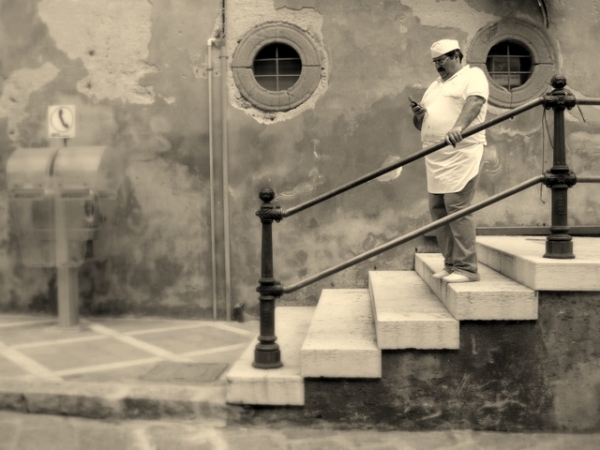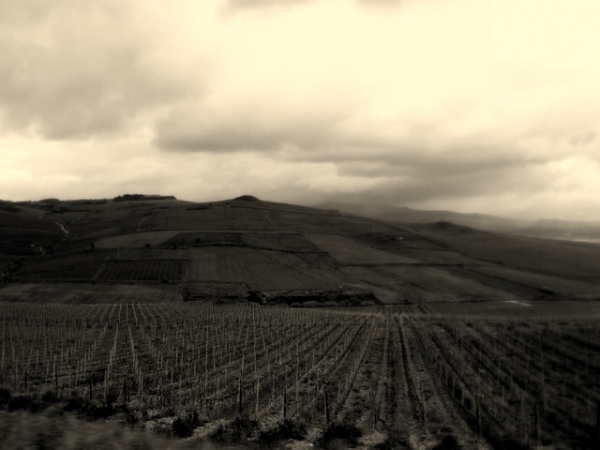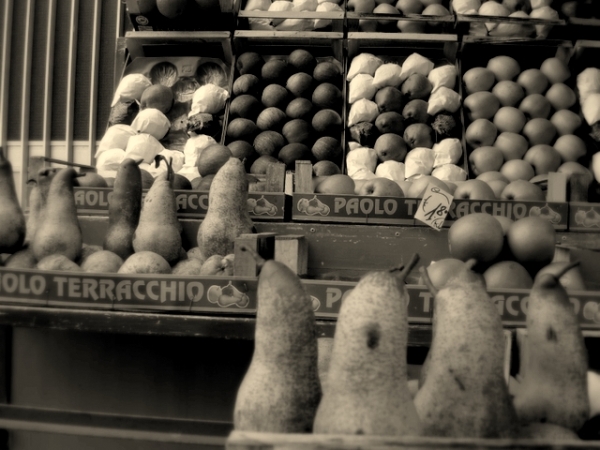Best of Sicily: Pictures that I love.
Lipari: Pagan Pagentry.
I’ve been on the island of Lipari for the last three days, resting up a bit, and passing Easter weekend in familiar surroundings. I rented a little room with a 4th-story terrace, and a kitchen, and I’ve been cooking again, with intermittent access (it’s the holy weekend) to markets and wine shops, many still peopled with the same folks I got to know when I passed four months here, almost 15 years ago.
There is nothing like it in the world, says Gilda, the owner of the place I’m staying. First the Madonna comes out. Then Baby Jesus. Then they are brought together and they kiss and then a million white doves are released and there are fireworks. Her eyes start to tear up. Nothing like it in the world.
Sounds pagan, I said. Why would Jesus and his mother kiss?
No, it’s Christian, she says, as if that explains it.
Still tender- and let’s just say ‘walking a lot like John Wayne’- from bicycling not only the height but also the width of Sicily, I headed for the marina corta Easter morning to see this festival, where hundreds of locals gathered to see the procession, quite literally all in their Sunday best. I couldn’t have been more right about the festivals pagan origins. And being right is such a rare feeling for me that I tried to milk it all morning long.
A life-sized Madonna was carried out of the duomo and shouldered down the island’s main street. A life-size statue of Jesus came down the corso as well (fully grown, although Jesus is often referred to as being a baby in Italian, even when fully adult). They met to sombre, marching band music and through some serious bowing and finagling, the carriers are able to get the two statues to ‘kiss’, just as fifty pigeons are released, and fireworks go off over the harbour. This of course scares the just-released birds, who then fly into open windows, light poles and just about everything else as they try to flee. I come to the realisation that, fireworks in the day time are really just expensive fire crackers in the air. I think the birds would agree. And regarding the festival, it’s difficult to believe that even the most fervent non-liparota catholic would see the festival for what is: the modern proof of the historical swapping of religious images without the swapping of new content. It’s a move from pagan fertility rites to the more modern Christianity, only with fireworks, the release of wildlife and simulated oedipal-necking, you know, that old chestnut.
I had reserved a table in the harbour right after the festival and had Easter lunch just meters away. I lingered over lunch, almost into dinner, nursing a bottle of Donna Fugata’s Tancredi until the waiters themselves sat down. It was nice not to ride a bike. Really nice.
And anyway, I came to Lipari to relax as I’ve said, but I also came to get a handle on Malvasia delle Lipari, a yellow, thick, sickly sweet dessert wine that is very expensive. However, perhaps, unlike last time I spent any real time here, I could actually learn to appreciate it, as one of the great dessert wines of the world. I bought a bottle made by Salvatore, the old geezer that makes my morning coffee- came in a glass Fiuggi water bottle, a reused beer cap secured in place with scotch tape (1 litre, 15 Euro). I bought a bottle of Hauner from the grocery store here, a fancy-smancy-packaged bottle (375ml, 18 Euro) and a bottle of Florio’s Passito, just for kicks (375 ml, 28 Euro). I tasted them all, side by side, from a Nutella jar/wine glass on my terrace, just before dinner last night. (It would certainly boggle the foreign mind to comprehend the quantity of wine consumed from old Nutella jars in Italy).
Here is what I learned. Dessert wines are mostly wasted on me, mostly because of all the sugar. The tasting was not unlike trying to drink pure honey and determine what sort of flower the bees ate. I could do it, but the overall effect put my jaw on edge. I felt a coating on my teeth. My saliva glands started to overproduce, perhaps trying to thin the think syrups. Asking around, and from my reading, I was supposed to find honey, flowers, jasmine, and orange blossoms. What I tasted was, sugar, sugar, sugar, sugar, honey, oak (in the Hauner and Florio), sugar and then maybe some orange blossoms, but only if I was really stretching. Further, for this kind of money, I could have had some damn fine wine, which I would have really appreciated, rather than drinking pure honey, looking for some hint of that orange syrup they use to make the sinister-sounding ‘orange drink’.
I packaged up the remainders of the bottles and gave them to my landlord, who tore into Salvatore’s right away, pronouncing it ‘buona’. I had dinner on the terrace tonight, a simple meal that to me really celebrates Sicilian island life: Pasta with a caper and green-olive pesto, pan-seared lamb with fresh herbs I had gathered and fresh artichokes, just sautéed. I rammed a pack of black-out candles into spent wine bottles and felt like a graduate student again, living meagrely but impressed with myself for making the most with what I had. A lot like island people themselves, however pagan in origin.
Trapani: Distilling A Sea.
SSHHHHHHHHHHHHHHHHHHHHHHHHH
SHHHHHHHHHHHHHHHHHHHHHHHHHHHHHH
SHHHHHHHHHHHHHHHHHHHHHHHHHHHH
SHHHHHHHHHHHHHHHHHHHHHHHHHH
Like a serious of long, sensual whispers, the brown and tan cattails that line the road outside of Trapani go on for hours, their sighing sounds seem to almost sizzle in the late afternoon as I near the old city, the shimmering salt pools perhaps one of the most welcoming sites I’ve ever seen. They seem imaginary, like some sales lot for unsold lakes, stacked side by side, the shores between them just thin strips of land.
The city of Trapani is hauntingly beautiful as well, the centre more European than Sicilian, more regal than you might expect from a city that has made its name by pulling salt from the sea using only the strong winds and sun, and then using that salt to dry and preserve food, long before refrigeration, canning and trucking changed everything.
What’s endearing, and maybe even promising, is how intact the cuisine still is even today, so little changed by tourism, refrigeration and more to the point, the bulldozing effects of ‘modern tastes’ (the thing about cuisine is that once it’s gone, it’s gone). Folks here still seem to prefer dried tuna to fresh, you find salt-cured capers and olives everywhere in the food and the pasta shape of choice is oddly called fusilli, even though they are fresh and look like tightly-curled telephone cords. Even in the better restaurants, my vegetables arrive with the tell-tale marks of the serrated-tooth scrapes of a common, plastic-handled table knife, a sign that things are still cut against the thumb rather than on a chopping board. Fish-based couscous is everywhere, and the desserts are so sweet that they make my teeth hurt just thinking about them: Trapani’s souvenirs from its Phoenician past. Taken together, the cooking here feels like it’s still ‘of a place’, something you find less and less, even in Italy.
Wobbling on my bike on the way out of town- the screaming winds ripping past my ears, and the sun burrowing into the back of my salty neck, I think about my school’s working definition of the word ‘cuisine’- how a people solved scarcity as a group over time ’– and it occurs to me that that pertains to Trapani itself as well. Harnessing their only resources, the sea, the famously-ripping wind, the cruel, bleaching almost-African sun and generation after generation of aching backs and blistered fingers, i trapanesi built a way of life and even a remarkable city together, which their food still reflects, beautifully. As I teeter along the white-capped and breaking sea, I think about everything we have in Italy today, and how little of it we actually earned ourselves.
 Feudo Arancio feels like a New World winery, a four-year-old, massive city-block of a building, modelled after a cloister, located on top of a beautiful hill in a part of Sicily that could be anywhere in the world. That’s assuming, of course, you’re in stunning, rolling wine country, the sleepy horizon broken only with olive, orange, lemon and Cyprus trees. Flash a picture of this to any foreigner and you can bet you’d hear the word ‘Tuscany’, first sentence. What’s odd about Feudo Arancio, is that there are no signs announcing the place whatsoever, not in the parking lot, not on the building itself, not out front, not even once you stumble inside and have actually started doing something that feels a whole lot like trespassing.
Feudo Arancio feels like a New World winery, a four-year-old, massive city-block of a building, modelled after a cloister, located on top of a beautiful hill in a part of Sicily that could be anywhere in the world. That’s assuming, of course, you’re in stunning, rolling wine country, the sleepy horizon broken only with olive, orange, lemon and Cyprus trees. Flash a picture of this to any foreigner and you can bet you’d hear the word ‘Tuscany’, first sentence. What’s odd about Feudo Arancio, is that there are no signs announcing the place whatsoever, not in the parking lot, not on the building itself, not out front, not even once you stumble inside and have actually started doing something that feels a whole lot like trespassing.
Through an office window I see a sole human being, an attractive woman that doesn’t look surprised to see me, nor bothered by my presence. Five minutes pass and then she surfaces and presents herself as Irene Luppino, in charge of Feudo Arancio’s External Relations. She’s pretty, well-dressed and eager to show me around and answer my barrage of questions, so eager in fact that an hour into the tour I’m convinced she’s mistaken me for someone else, someone much more important.
Do you take this kind of time for everyone that comes, I ask. She smiles the most incredible smile I’ve ever been responsible for and my heart cracks. It’s a big, almost horse-like, generous and toothy smile; Julia Robert’s long lost Sicilian cousin. Each time she smiles I feel like I’ve done something meaningful, almost noble and within minutes I notice what, in fact, is making her smile, -what kind of questions and comments- and then like an idiot I start to construct my sentences thusly, almost forgetting about gathering any information about wine. At one point she asks me if my face is always so red, or is it just from all the bicycling: I catch my reflection in the polished surfaces of the stainless steel tanks and realise that I’ve been blushing the entire time.
I ask Irene three, very pointed questions, to which she doesn’t back down even a half-step. I ask, 1) Is Feudo Arancio seen internally as really just a major must provider for Mezza Corona, 2) Why do they make more non-autochthones-based wines than auctoctounous and 3) How mixed are their wines and what do they hope to gain from that mixing?
She smiles again (and I quickly scan the room for a defibrillator) and she says that, 1) Some of the must IS sent up north to round out the Mezza Corona line, but that it isn’t the primary purpose for the Sicilian operation. That, 2) the non-autochthonous grape-based wines are market entry ones, that consumers are likely to try an insolia only after they have tried and liked a chardonnay. And further, that many New World shop-keepers shelf their wines by grape, not brand nor nation. That it’s just simple marketing. That, 3) Feudo Arancio doesn’t mix grapes at all: Their Grillo is straight Grillo, their Cabernet straight Cabernet, etc.
I’ve been talking Sicilian wine fifteen hours a day for a few weeks now and this is the most alarming news to date. It simply doesn’t fit into my mental model, whatsoever. When you ask other Sicilian producers, they will tell you that the so-called International Varietals are used to round out and compensate for the gaps that occur between indigenous grapes and what the international market wants today, the Parker-esque, high-alcohol, dry but fruit-forward powerhouses. But Feudo Arancio doesn’t mix their grapes at all, and the only compensation going on, is where the wines fit on the shelves around the world.
The must question is an interesting one, something approaching a dirty little secret in Italian wine. It’s so illegal to chapitalize in Italy- adding table sugar to a wine to boost it’s alcohol and thus body- that Irene says that they even have to report how many sugar packets they use at the company coffee machine. Many, many of your favourite central and northern Italian wineries are actually rounding out their wines with must (grape juice, or raw, unfermented wine) from the south, something to think about the next time you see an article about ‘the power and structure of Barolo’ or ‘the nobility of Barbaresco’. But then again this is somewhat common knowledge, up there with the fact that your supermarket Tuscan olive oil isn’t really Tuscan (if it’s even Italian, it’s from the south) or the amount of famously-celebrated vegetables that no longer grow anywhere near the cities they were named after.
The Feudo Arancio line is sort of the like the California-based Gallo used to be, in that it produces good, solid wines that hover around the 5 Euro mark (a bottle of their Grillo was excellent and the most pristine example of the grape I’ve had, the bottle coming in at Euro 4.20). It’s unlikely they will be your favourite wines from Sicily, but it’s also unlikely that you’d ever feel that your money was wasted on a bottle, or that you’d be embarrassed to serve them to even cherished guests. For North Americans and those in Northern Europe, these wines represent serious competition to the New World wines you’re drinking on Tuesday nights. (I didn’t think to ask for those of you residing in Australia, New Zealand or South Africa, but you can certainly find out on their site).
Mezza Corona, a massive-industrial winery in Trentino, invested 45 million Euro in Sicilia. This is a drop in the bucket compared to what Italy and the rest of Europe have invested in Sicilia, the difference being that a private company is going to actually micro-manage its investment, where as governments tend to follow investments about as well as someone giving coins to a panhandler. I’ve been to Mezza Corona and have had a number of their wines over the years. I prefer their Feudo Arancio Sicilians, which are gutsier, as opposed to what wine writers often refer to as ‘Northern Austerity’, which to me is just another phrase for ‘boring but expensive’. If you’re really interested in Sicily and Sicilian wines, you’ll skip their French-based wines but try their Grillo, Insolia and Nero d’Avola, which all represent not only excellent value but intriguing wines based on what are likely to be unfamiliar grapes. They’re wines that somehow make the world seem a little bigger, that there is still so much to learn about Italian wine, but in a good way.
I spent the second half of the day at the ruins of Akragus at Agrigento, wandering among throngs of tourists for the first time since I’ve been in Sicilia. Elderly Germans snapped pictures. Bus-fulls of Japanese all nodded when prompted by their ear-phoned audio tours. Scottish children bellied up fallen pillars. I thought about the role Sicily plays with respect to the outside world, both what Sicilian wines represent when consumed in Sidney, Toronto or San Diego, and too, how many foreigners are willing to take the trouble to seek out that elusive algebra of influences that sets Sicily apart from the rest of Italy.
In my saddle bags I had a bottle of Feudo Arancio’s Grillo, which I am drinking right now from the bottle, sitting up in the hotel room bed, typing into this computer, my dusty red shoes, connecting the two. 










